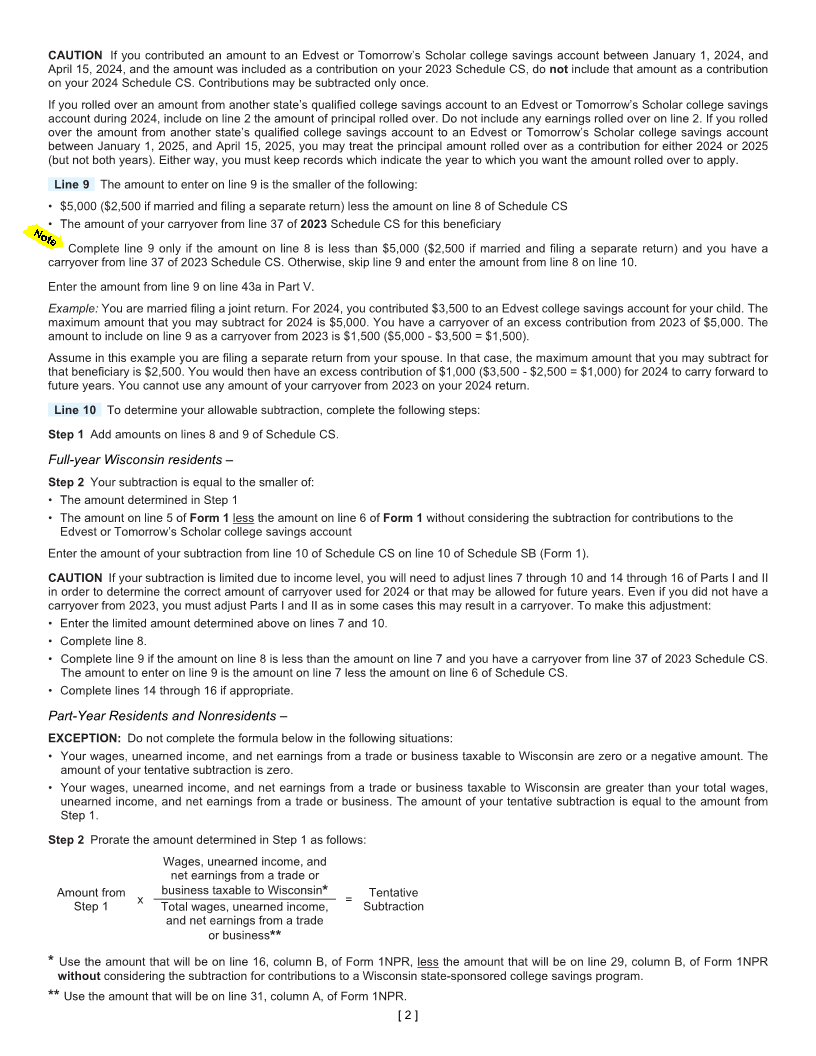
Enlarge image
2024 Schedule CS Instructions
College Savings Accounts (Edvest and Tomorrow’s Scholar)
Purpose of Schedule CS
Wisconsin provides a subtraction from income for amounts contributed to the Wisconsin state-sponsored college savings program. There
are two Wisconsin plans that qualify for the subtraction, Edvest and Tomorrow’s Scholar.
The Edvest and Tomorrow’s Scholar programs are both a qualified tuition program (QTP) under the federal Internal Revenue Code. They
are also called “529 plans.”
Who Must File Schedule CS
Schedule CS must be filed by persons who:
• Claim a subtraction from income for contributions to an Edvest or Tomorrow’s Scholar college savings account, or
• Received a distribution from an Edvest or Tomorrow’s Scholar college savings account that was not used for qualified higher education
expenses, or
• Rolled over an amount from an Edvest or Tomorrow’s Scholar college savings account into another state’s qualified tuition program,
or
• Rolled over an amount from an Edvest or Tomorrow’s Scholar college savings account into a qualified ABLE account, or
• Rolled over an amount from an Edvest or Tomorrow's Scholar college savings account into a Roth IRA for the beneficiary, or
• Using a first-in, first-out method, received a distribution from an Edvest or Tomorrow’s Scholar college savings account within 365 days
after the date the contribution was made. You must complete Schedule CS even if the contribution and withdrawal are made in the
same taxable year.
Note: If you have more than one Edvest or Tomorrow’s Scholar college savings account, complete a separate Schedule CS for each
account with different beneficiaries. If you contributed to an account owned by you and an account owned by someone else, and the
contributions are for the same beneficiary, you only need to complete one Schedule CS.
General Instructions
When can contributions be made? Contributions to an Edvest or Tomorrow’s Scholar college savings account for 2024 must be made
during 2024 or on or before April 15, 2025. For contributions made between January 1, 2025 and April 15, 2025, you must keep records
which indicate you want the contributions to apply to tax year 2024; otherwise, they will be considered 2025 contributions. Note: If you
file your return on a fiscal-year basis, the last day for making contributions is the 15th day of the 4th month beginning after the close of
the taxable year. If any due date falls on a Saturday, Sunday, or legal holiday, use the next business day.
Who can contribute to an account? The owner of an Edvest or Tomorrow’s Scholar college savings account may contribute to the
account. The owner of the account may also authorize any other person to contribute to the account.
May I subtract my contribution to the Edvest or Tomorrow’s Scholar college savings account from income? You may be able to
subtract the amount you contributed to an Edvest or Tomorrow’s Scholar college savings account if you are the owner of the account or
were authorized by the owner to make contributions to the account. The subtraction is equal to the amount you contributed to the account
for 2024, but not more than $5,000 per beneficiary ($2,500 per beneficiary if you are married and filing a separate return).
The total subtraction for a married couple may not exceed $5,000 per beneficiary.
Example: You are married filing a joint return and have two children. You established an Edvest or Tomorrow’s Scholar college savings
account for each child. For 2024, you contributed $6,000 to the account of each child. You may claim a subtraction of $10,000 ($5,000 x
2).
In the example above, if the couple filed separate returns (filing status of married filing separately or head of household, married), each
spouse would be limited to a maximum subtraction of $5,000 ($2,500 x 2).
Your subtraction is also limited in that it cannot reduce your Wisconsin income to less than zero. Part-year residents and nonresidents
are required to prorate the subtraction.
Specific Instructions
Part I Contributions to an Edvest or Tomorrow’s Scholar college savings account
Complete Section A if you are the owner of the Edvest or Tomorrow’s Scholar college savings account for which you made a contribution.
Complete Section B if you made a contribution to an Edvest or Tomorrow’s Scholar college savings account for which you are not the
owner of the account. Enter the name and address of the owner of the account for which you made a contribution on line 3.
Lines 1 and 4 Enter the name of the beneficiary of the account(s).
Lines 2 and 5 Enter the amount you contributed to the account(s) for 2024. (See “When can contributions be made?”.)
I-192 (R. 10-24) Wisconsin Department of Revenue




